Software for Embedded Vision

“Building Agentic Applications for the Edge,” a Presentation from GMAC Intelligence
Amit Mate, Founder and CEO of GMAC Intelligence, presents the “Building Agentic Applications for the Edge” tutorial at the May 2025 Embedded Vision Summit. Along with AI agents, the new generation of large language models, vision-language models and other large multimodal models are enabling powerful new capabilities that promise to… “Building Agentic Applications for the
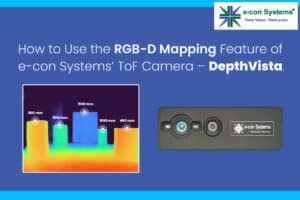
How to Use the RGB-D Mapping Feature of e-con Systems’ DepthVista ToF Camera
This blog post was originally published at e-con Systems’ website. It is reprinted here with the permission of e-con Systems. Learn how to leverage the RGB-D mapping feature of e-con Systems’ DepthVista ToF camera to align RGB and depth data for precise 3D vision applications. This step-by-step guide covers camera calibration, the role of intrinsic
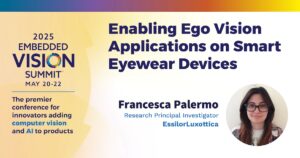
“Enabling Ego Vision Applications on Smart Eyewear Devices,” a Presentation from EssilorLuxottica
Francesca Palermo, Research Principal Investigator at EssilorLuxottica, presents the “Enabling Ego Vision Applications on Smart Eyewear Devices” tutorial at the May 2025 Embedded Vision Summit. Ego vision technology is revolutionizing the capabilities of smart eyewear, enabling applications that understand user actions, estimate human pose and provide spatial awareness through simultaneous… “Enabling Ego Vision Applications on

LLiMa: SiMa.ai’s Automated Code Generation Framework for LLMs and VLMs for <10W
This blog post was originally published at SiMa.ai’s website. It is reprinted here with the permission of SiMa.ai. In our blog post titled “Implementing Multimodal GenAI Models on Modalix”, we describe how SiMa.ai’s MLSoC Modalix enables Generative AI models to be implemented for Physical AI applications with low latency and low power consumption. We implemented
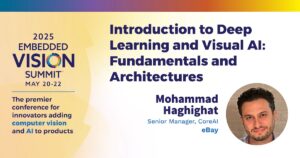
“Introduction to Deep Learning and Visual AI: Fundamentals and Architectures,” a Presentation from eBay
Mohammad Haghighat, Senior Manager for CoreAI at Bay, presents the “Introduction to Deep Learning and Visual AI: Fundamentals and Architectures” tutorial at the May 2025 Embedded Vision Summit. This talk provides a high-level introduction to artificial intelligence and deep learning, covering the basics of machine learning and the key concepts… “Introduction to Deep Learning and

Why Synthetic Data Is Shaping the Future of Computer Vision
This blog post was originally published at Geisel Software’s Symage website. It is reprinted here with the permission of Geisel Software. The future of “seeing” Synthetic data solves data bottlenecks: It reduces the time and cost of collecting and labeling data—particularly rare edge cases—which often consume the majority of AI development time. Complex scenes remain
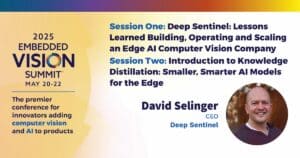
“Deep Sentinel: Lessons Learned Building, Operating and Scaling an Edge AI Computer Vision Company,” a Presentation from Deep Sentinel
David Selinger, CEO of Deep Sentinel, presents the “Deep Sentinel: Lessons Learned Building, Operating and Scaling an Edge AI Computer Vision Company” tutorial at the May 2025 Embedded Vision Summit. Deep Sentinel’s edge AI security cameras stop some 45,000 crimes per year. Unlike most security camera systems, they don’t just… “Deep Sentinel: Lessons Learned Building,
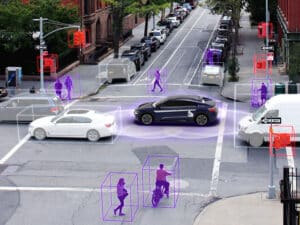
Automated Driving for All: Snapdragon Ride Pilot System Brings State-of-the-art Safety and Comfort Features to Drivers Across the Globe
This blog post was originally published at Qualcomm’s website. It is reprinted here with the permission of Qualcomm. Qualcomm Technologies, Inc. introduces Snapdragon Ride Pilot at IAA Mobility 2025 What you should know: Qualcomm Technologies, Inc. has introduced Snapdragon Ride Pilot to help make driving more safety-focused and convenient for people around the world. Features
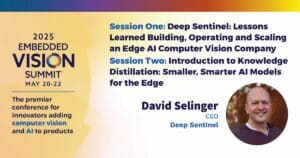
“Introduction to Knowledge Distillation: Smaller, Smarter AI Models for the Edge,” a Presentation from Deep Sentinel
David Selinger, CEO of Deep Sentinel, presents the “Introduction to Knowledge Distillation: Smaller, Smarter AI Models for the Edge” tutorial at the May 2025 Embedded Vision Summit. As edge computing demands smaller, more efficient models, knowledge distillation emerges as a key approach to model compression. In this presentation, Selinger delves… “Introduction to Knowledge Distillation: Smaller,

Smarter, Faster, More Personal AI Delivered on Consumer Devices with Arm’s New Lumex CSS Platform, Driving Double-digit Performance Gains
News Highlights: Arm Lumex CSS platform unlocks real-time on-device AI use cases like assistants, voice translation and personalization, with new SME2-enabled Arm CPUs delivering up to 5x faster AI performance Developers can access SME2 performance with KleidiAI, now integrated into all major mobile OSes and AI frameworks, including PyTorch ExecuTorch, Google LiteRT, Alibaba MNN and
Qualcomm and Google Cloud Deepen Collaboration to Bring Agentic AI Experiences to the Auto Industry
Highlights: Landmark technical collaboration brings together the strengths of two industry leaders with Google Gemini models and Qualcomm Snapdragon Digital Chassis solutions to help automakers create deeply personalized and advanced AI agents that will redefine customers’ experiences at every point in their journeys. Combines the best of both worlds – powerful on-device AI for instant,
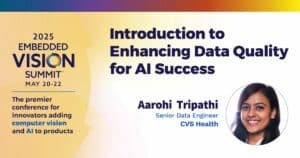
“Introduction to Enhancing Data Quality for AI Success,” a Presentation from CVS Health
Aarohi Tripathi, Senior Data Engineer at CVS Health, presents the “Introduction to Enhancing Data Quality for AI Success,” tutorial at the May 2025 Embedded Vision Summit. In this presentation, Tripathi focuses on the critical role that high-quality data plays in the effectiveness and accuracy of AI models. Since AI systems… “Introduction to Enhancing Data Quality
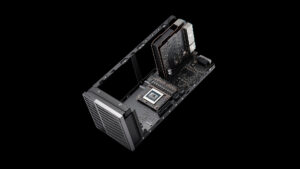
Accelerate Autonomous Vehicle Development with the NVIDIA DRIVE AGX Thor Developer Kit
This blog post was originally published at NVIDIA’s website. It is reprinted here with the permission of NVIDIA. Autonomous vehicle (AV) technology is rapidly evolving, fueled by ever-larger and more complex AI models deployed at the edge. Modern vehicles now require not only advanced perception and sensor fusion, but also end-to-end deep learning pipelines that
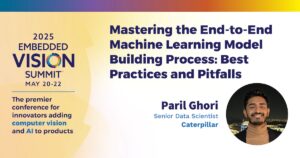
“Mastering the End-to-end Machine Learning Model Building Process: Best Practices and Pitfalls,” a Presentation from Caterpillar
Paril Ghori, Senior Data Scientist at Caterpillar, presents the “Mastering the End-to-end Machine Learning Model Building Process: Best Practices and Pitfalls” tutorial at the May 2025 Embedded Vision Summit. In this talk, Ghori explores the complete machine learning model building process, providing data scientists and ML engineers with practical insights… “Mastering the End-to-end Machine Learning
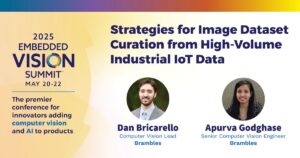
“Strategies for Image Dataset Curation from High-volume Industrial IoT Data,” a Presentation from Brambles
Dan Bricarello, Computer Vision Lead, and Apurva Godghase, Senior Computer Vision Engineer, both of Brambles, co-present the “Strategies for Image Dataset Curation from High-volume Industrial IoT Data” tutorial at the May 2025 Embedded Vision Summit. In industrial supply chain and logistics applications, edge IoT devices capture data continuously, generating massive… “Strategies for Image Dataset Curation

Qualcomm and BMW Group Unveil Groundbreaking Automated Driving System with Jointly Developed Software Stack
Highlights: AI-enabled Snapdragon Ride Pilot Automated Driving System, powered by Snapdragon Ride system-on-chips and a new jointly developed automated driving software stack, debuts in the all-new BMW iX3 at IAA Mobility 2025. System is validated in 60 countries worldwide and is targeted to be available in more than 100 countries by 2026. Scalable platform enabling
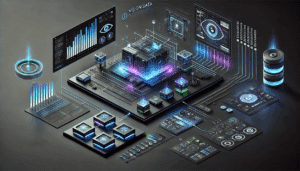
Building a Versatile Vision Data Simulation Platform: Key Components and Architecture
This blog post was originally published at Geisel Software’s Symage website. It is reprinted here with the permission of Geisel Software. Are Real-World Data Limitations Holding Back Your AI Models? KEY TAKEAWAYS: Versatile Data Simulation Powers Industry Relevance A truly effective vision data simulation platform leverages modular architecture and configurable domain parameters to adapt seamlessly
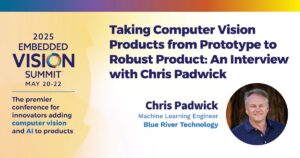
“Taking Computer Vision Products from Prototype to Robust Product,” an Interview with Blue River Technology
Chris Padwick, Machine Learning Engineer at Blue River Technology, talks with Mark Jamtgaard, Director of Technology at RetailNext for the “Taking Computer Vision Products from Prototype to Robust Product,” interview at the May 2025 Embedded Vision Summit. When developing computer vision-based products, getting from a proof of concept to a… “Taking Computer Vision Products from

